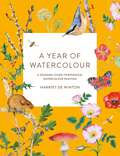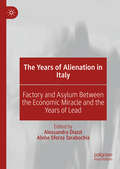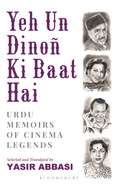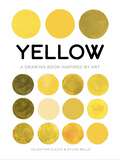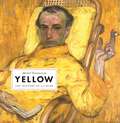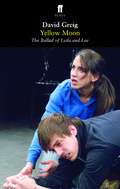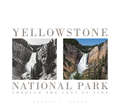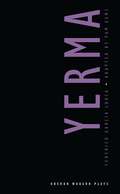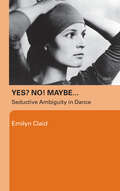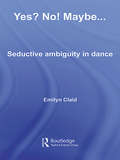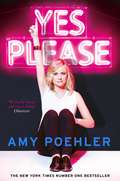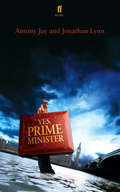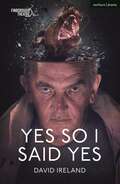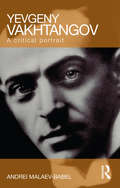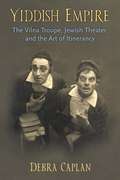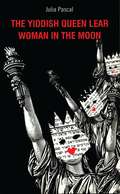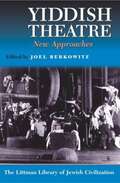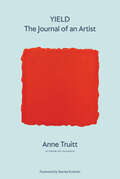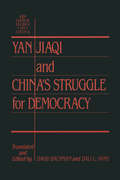- Table View
- List View
A Year of Watercolour: A Seasonal Guide to Botanical Watercolour Painting
by Harriet de WintonCreate beautiful botanical artworks, engage with the natural world around you, and take pleasure in the changing seasons with A Year of Watercolour. Award-winning and bestselling artist and tutor Harriet de Winton takes you through more than 30 step-by-step botanical paintings that span the seasons. Learn to paint cherry blossoms and lambs in the spring, honeybees and wildflowers for summer, oak leaves and harvest mice in autumn, and pine trees and snowdrops in winter. Plus, enjoy charming bonus features like a recipe for wild garlic pesto in springtime, or guidance on how to paint a festive wreath with winter berries and foliage. The perfect primer for creating seasonal cards, personalized stationery and stunning artworks to decorate your home or give to friends and family.
A Year Unfolding: A Printmaker's View
by Angela HardingA beautifully illustrated guide to nature through the seasons by much-loved printmaker Angela Harding.The cover of this stunning book has an exclusive triptych printed on the reverse - a perfect collector's itemThis stunning work, the first book that is solely dedicated to Angela's art, is a celebration of her beautiful prints, and a glimpse into her detailed and meticulous process.A Year Unfolding is a journey through Angela's year in nature watching the seasons unfold in front of her from her studio in Rutland, and giving the reader detail into how nature transforms and evolves over the course of the year.A Year Unfolding also tells the stories behind some of Angela's most popular images, giving context to Angela's celebrated work, as well as new art created specifically for the book.The beautiful illustrations and evocative imagery of the prose make this the perfect book for Angela's fans and readers and art lovers everywhere.Angela has created the covers for many bestselling books, including The Salt Path and The Wild Silence by Raynor Winn, October, October by Katya Balen, English Pastoral by James Rebanks, Christmas is Murder by Val McDermid and RSPB Birds among many others.
The Years of Alienation in Italy: Factory and Asylum Between the Economic Miracle and the Years of Lead
by Alessandra Diazzi Alvise Sforza TarabochiaThe Years of Alienation in Italy offers an interdisciplinary overview of the socio-political, psychological, philosophical, and cultural meanings that the notion of alienation took on in Italy between the 1960s and the 1970s. It addresses alienation as a social condition of estrangement caused by the capitalist system, a pathological state of the mind and an ontological condition of subjectivity. Contributors to the edited volume explore the pervasive influence this multifarious concept had on literature, cinema, architecture, and photography in Italy. The collection also theoretically reassesses the notion of alienation from a novel perspective, employing Italy as a paradigmatic case study in its pioneering role in the revolution of mental health care and factory work during these two decades.
Yeh Un Dinoñ Ki Baat Hai: Urdu Memoirs of Cinema Legends
by Yasir AbbasiPeppered with heartfelt accounts and charming anecdotes, Urdu film magazines were in great favour with the public from the 1930s through the 1990s – a considerable period of seven decades. As Urdu got progressively marginalised in the later years, unfortunately these magazines were not archived for the most part, leading to their inevitable disappearance from popular imagination. Tracking down the lost publications, Yasir Abbasi followed leads – some futile, some fruitful – to obscure towns and people's homes in a last-ditch effort to save valuable records of Indian cinema. As challenging as it was to locate the faded issues and original texts, he managed to uncover and translate many fabulous memoirs covering a wide gamut of our favourite old artistes at their candid best. A gloom-laced piece on Meena Kumari by Nargis, a rollicking description by Raja Mehdi Ali Khan of an eventful evening with Manto (not to mention a mysterious woman and a house on fire), Jaidev writing about his chequered career, Balraj Sahni introspecting about the relevance of Hindi and Urdu in films – it's a rich mix of engrossing narratives brought back from oblivion.
Yellow: A Drawing Book Inspired by Art (True Color)
by Sylvie Bello Valentina ZucchiMany people crave a creative outlet, but more often than not, don't know where to start. In Yellow, Valentina Zucchi and Sylvie Bello invite you to nurture your creativity and build your confidence by taking inspiration from modern works of art that celebrate yellow, the most cheerful and inviting of colours.Explore some of the many different yellows that artists have used over the years to give substance to the beauty of light, from precious gold to butterscotch and cadmium yellow. Throughout the book, Valentina and Sylvie provide creative and fun prompts – many based on famous works of art – which will encourage you to draw or paint on the pages using various techniques. Packed with inspiration from the world's most celebrated artists, including Olafur Eliassoni, Vincent van Gogh, JMW Turner and more, you will discover the many shades of yellow and just some of the ways it can be used to convey meaning.Yellow is a short course in unlocking your creative self – perfect for budding artists of all ages who are keen to try out different techniques and materials and begin their artistic journey.
Yellow: The History of a Color
by Michel PastoureauFrom the acclaimed author of Blue, a beautifully illustrated history of yellow from antiquity to the presentIn this richly illustrated book, Michel Pastoureau—a renowned authority on the history of color and the author of celebrated volumes on blue, black, green, and red—now traces the visual, social, and cultural history of yellow. Focusing on European societies, with comparisons from East Asia, India, Africa, and South America, Yellow tells the intriguing story of the color’s evolving place in art, religion, fashion, literature, and science.In Europe today, yellow is a discreet color, little present in everyday life and rarely carrying great symbolism. This has not always been the case. In antiquity, yellow was almost sacred, a symbol of light, warmth, and prosperity. It became highly ambivalent in medieval Europe: greenish yellow came to signify demonic sulfur and bile, the color of forgers, lawless knights, Judas, and Lucifer—while warm yellow recalled honey and gold, serving as a sign of pleasure and abundance. In Asia, yellow has generally had a positive meaning. In ancient China, yellow clothing was reserved for the emperor, while in India the color is associated with happiness. Above all, yellow is the color of Buddhism, whose temple doors are marked with it.Throughout, Pastoureau illuminates the history of yellow with a wealth of captivating images. With its striking design and compelling text, Yellow is a feast for the eye and mind.
Yellow: The History of a Color
by Michel PastoureauFrom the acclaimed author of Blue, a beautifully illustrated history of yellow from antiquity to the presentIn this richly illustrated book, Michel Pastoureau—a renowned authority on the history of color and the author of celebrated volumes on blue, black, green, and red—now traces the visual, social, and cultural history of yellow. Focusing on European societies, with comparisons from East Asia, India, Africa, and South America, Yellow tells the intriguing story of the color’s evolving place in art, religion, fashion, literature, and science.In Europe today, yellow is a discreet color, little present in everyday life and rarely carrying great symbolism. This has not always been the case. In antiquity, yellow was almost sacred, a symbol of light, warmth, and prosperity. It became highly ambivalent in medieval Europe: greenish yellow came to signify demonic sulfur and bile, the color of forgers, lawless knights, Judas, and Lucifer—while warm yellow recalled honey and gold, serving as a sign of pleasure and abundance. In Asia, yellow has generally had a positive meaning. In ancient China, yellow clothing was reserved for the emperor, while in India the color is associated with happiness. Above all, yellow is the color of Buddhism, whose temple doors are marked with it.Throughout, Pastoureau illuminates the history of yellow with a wealth of captivating images. With its striking design and compelling text, Yellow is a feast for the eye and mind.
The Yellow House: Van Gogh, Gauguin, and Nine Turbulent Weeks in Arles
by Martin GayfordREVISED AND UPDATED EDITION'Masterly . . . a wonderfully alert and moving portrait' Mail on Sunday---------------------Two artistic giants. One small house.From October to December 1888 a pair of at the time largely unknown artists lived under one roof in the French provincial town of Arles. Paul Gauguin and Vincent Van Gogh ate, drank, talked, argued, slept and painted in one of the most intense and astonishing creative outpourings in history. Yet as the weeks passed Van Gogh buckles under the strain, fought with his companion and committed an act of violence on himself that prompted Gauguin to flee without saying goodbye to his friend.The Yellow House is an intimate portrait of their time together as well as a subtle exploration of a fragile friendship, art, madness, genius behind a shocking act of self-mutilation that the world has sought to explain ever since.---------------------'Gayford's fascinating depiction of the Odd Couple of art history is both moving and riveting' Daily Mail'Profoundly absorbing. Gayford has reconstructed these tumultuous weeks . . . the reader lives them day by day, almost minute by minute. Delightful, utterly fascinating' Independent on Sunday
Yellow Moon: The Ballad Of Leila And Lee
by David GreigYellow Moon is a modern Bonnie and Clyde tale that follows the fortunes of two teenagers on the run. Silent Leila is an introverted girl who has a passion for celebrity magazines. Stag Lee Macalinden is the deadest of dead-end kids in a dead-end town. They never meant to get mixed up in a murder... but now they need a place to hide.Yellow Moon explores what it means to live in a celebrity-obsessed world and what it is that defines who you are when you're 17 years old. The play premiered at the Circle Studio of Citizens' Theatre, Glasgow, in September 2006, and won the 2008 Brain Way Award for Best Play for Young People.
Yellowstone National Park: Through the Lens of Time
by Bradly J. BonerPioneer photographer William Henry Jackson’s photographs from the 1871 Hayden Survey were instrumental in persuading Congress to designate Yellowstone as a national park—America’s first and greatest experiment in the preservation of an extraordinary landscape. Yellowstone National Park: Through the Lens of Time is an extended visual essay presenting Jackson’s images paired with breathtaking color rephotographs of each view from photojournalist Bradly J. Boner. These contemporary comparisons to Jackson’s originals reveal just how well that experiment has stood the test of time. Yellowstone is always changing. The Grand Canyon is getting deeper and wider as the Yellowstone River carves a chasm into the earth. The flows of the great hot springs at Mammoth are creating new layers of delicate, colorful cascades and leaving the old terraces to crumble in decay. Roads, bridges, and pathways wind through the park, and there are restaurants, campgrounds, and hotels. Yet even with the impact of humanity, Yellowstone remains remarkably intact, evidence that the effort to preserve and sustain the park for future generations has been a success. Combining more than 100 gorgeous “then and now” sets of photographs—the first complete published collection of Jackson’s images from the 1871 Hayden Survey and a result of Boner's three years of work rephotographing them—with history, extensive notes, and personal tales, Yellowstone National Park: Through the Lens of Time pays homage to the park’s early history and its present state, and offers a glimpse into the future. The great experiment of Yellowstone—which captivates millions of visitors from all corners of the globe each year—has transcended generations and should be maintained for generations to come. The University Press of Colorado and the author gratefully acknowledge the generous contributions of the many donors to the Kickstarter campaign supporting the publication of this book.
Yerma (Oberon Modern Plays)
by Federico Garcia Lorca Pam GemsIn a remote Spanish village Yerma, a woman of full of life and passion, longs for a child but is unable to conceive. This compelling and elemental tale of a woman's quest for a child taps into some of the most universal themes of theatre - love, passion, sexuality, marriage. In this adaptation, Pam Gems has stripped the text to the poetic core of Lorca's words in all their epic glory. Vibrant and sweeping, combining elements of dance and song, Yerma is an exhilarating theatrical event.
Yes? No! Maybe…: Seductive Ambiguity in Dance
by Emilyn ClaidCovering fifty years of British dance, from Margot Fonteyn to innovative contemporary practitioners such as Wendy Houstoun and Nigel Charnock, Yes? No! Maybe is an innovative approach to performing and watching dance. Emilyn Claid brings her life experience and interweaves it with academic theory and historical narrative to create a dynamic approach to dance writing. Using the 1970s revolution of new dance as a hinge, Claid looks back to ballet and forward to British independent dance which is new dance’s legacy. She explores the shifts in performer-spectator relationships, and investigates questions of subjectivity, absence and presence, identity, gender, race and desire using psychoanalytical, feminist, postmodern, post-structuralist and queer theoretical perspectives. Artists and practitioners, professional performers, teachers, choreographers and theatre-goers will all find this book an informative and insightful read.
Yes? No! Maybe…: Seductive Ambiguity in Dance
by Emilyn ClaidCovering fifty years of British dance, from Margot Fonteyn to innovative contemporary practitioners such as Wendy Houstoun and Nigel Charnock, Yes? No! Maybe is an innovative approach to performing and watching dance. Emilyn Claid brings her life experience and interweaves it with academic theory and historical narrative to create a dynamic approach to dance writing. Using the 1970s revolution of new dance as a hinge, Claid looks back to ballet and forward to British independent dance which is new dance’s legacy. She explores the shifts in performer-spectator relationships, and investigates questions of subjectivity, absence and presence, identity, gender, race and desire using psychoanalytical, feminist, postmodern, post-structuralist and queer theoretical perspectives. Artists and practitioners, professional performers, teachers, choreographers and theatre-goers will all find this book an informative and insightful read.
Yes Please
by Amy PoehlerThe New York Times number one bestseller from the Saturday Night Live and Parks and Recreation star.In Amy Poehler's highly anticipated first book, Yes Please, she offers up a big juicy stew of personal stories, funny bits on sex and love and friendship and parenthood and real life advice (some useful, some not so much).Powered by Amy's charming and hilarious, biting yet wise voice, Yes Please is a book full of words to live by.
Yes Prime Minister: a play
by Antony Jay Jonathan LynnYes, Minister, and the equally successful sequel Yes, Prime Minister captured a niche in the political consciousness of the nation. First broadcast thirty years ago, the original writers of these classic series have reunited to create a bang up to date Yes, Prime Minister for the stage. Spin, blackberries, sexed-up dossiers, sleaze, global warming and a country on the brink of financial meltdown form the backdrop to mayhem at Chequers as the Foreign Minister of Kumranistan makes a seriously compromising offer of salvation. Prime Minister Jim Hacker remains in power with his coterie of close advisors including Cabinet Secretary Sir Humphrey Appleby and Principal Private Secretary Bernard Woolley, but for how long? They govern a whole new world. Yes, Prime Minister premiered in the Festival Theatre, Chichester, in May 2010.
Yes So I Said Yes (Modern Plays)
by David IrelandIt's harder to kill people when there's a peace process on.Ulster Loyalist Alan Black is kept awake every night by his neighbour McCorrick's dog barking. To add to his difficulties, McCorrick refuses to acknowledge that he even owns a dog, let alone one that is creating a disturbance.In a Northern Ireland he barely recognises, where politics has proved just to be the continuation of war by other means, a disconsolate Alan sets out to rid himself of the incessant noise. As he seeks help from authority figures, he finally – as a very last resort – turns to the only voice he can really trust, Eamonn Holmes…Coinciding with the 100th anniversary of the partition of Ireland and the foundation of Northern Ireland, Yes So I Said Yes is a blackly comic, ferocious, dystopian satire about what it's like to feel alone in a place where everyone else is conspiring to erase you and your history.This edition was published to coincide with the production at London's Finborough Theatre in November 2021.
Yes So I Said Yes (Modern Plays)
by David IrelandIt's harder to kill people when there's a peace process on.Ulster Loyalist Alan Black is kept awake every night by his neighbour McCorrick's dog barking. To add to his difficulties, McCorrick refuses to acknowledge that he even owns a dog, let alone one that is creating a disturbance.In a Northern Ireland he barely recognises, where politics has proved just to be the continuation of war by other means, a disconsolate Alan sets out to rid himself of the incessant noise. As he seeks help from authority figures, he finally – as a very last resort – turns to the only voice he can really trust, Eamonn Holmes…Coinciding with the 100th anniversary of the partition of Ireland and the foundation of Northern Ireland, Yes So I Said Yes is a blackly comic, ferocious, dystopian satire about what it's like to feel alone in a place where everyone else is conspiring to erase you and your history.This edition was published to coincide with the production at London's Finborough Theatre in November 2021.
Yevgeny Vakhtangov: A Critical Portrait
by Andrei Malaev-BabelYevgeny Vakhtangov was a pioneering theatre artist who married Stanislavski’s demands for inner truth with a singular imaginative vision. Directly and indirectly, he is responsible for the making of our contemporary theatre: that is Andrei Malaev-Babel’s argument in this, the first English-language monograph to consider Vakhtangov’s life and work as actor and director, teacher and theoretician. Ranging from Moscow to Israel, from Fantastic Realism to Vakhtangov’s futuristic projection, the theatre of the ‘Eternal Mask’, Yevgeny Vakhtangov: A Critical Portrait: considers his input as one of the original teachers of Stanislavsky’s system, and the complex relationship shared by the two men; reflects on his directorship of the First Studio of the Moscow Art Theatre and the Habima (which was later to become Israel's National Theatre) as well as the Vakhtangov Studio, the institution he established; examines in detail his three final directorial masterpieces, Erick XIV, The Dybbuk and Princess Turandot. Lavishly illustrated and elegantly conceived, Yevgeny Vakhtangov represents the ideal companion to Malaev-Babel’s Vakhtangov Sourcebook (2011). Together, these important critical interventions reveal Vakhtangov’s true stature as one of the most significant representatives of the Russian theatrical avant-garde.
Yevgeny Vakhtangov: A Critical Portrait
by Andrei Malaev-BabelYevgeny Vakhtangov was a pioneering theatre artist who married Stanislavski’s demands for inner truth with a singular imaginative vision. Directly and indirectly, he is responsible for the making of our contemporary theatre: that is Andrei Malaev-Babel’s argument in this, the first English-language monograph to consider Vakhtangov’s life and work as actor and director, teacher and theoretician. Ranging from Moscow to Israel, from Fantastic Realism to Vakhtangov’s futuristic projection, the theatre of the ‘Eternal Mask’, Yevgeny Vakhtangov: A Critical Portrait: considers his input as one of the original teachers of Stanislavsky’s system, and the complex relationship shared by the two men; reflects on his directorship of the First Studio of the Moscow Art Theatre and the Habima (which was later to become Israel's National Theatre) as well as the Vakhtangov Studio, the institution he established; examines in detail his three final directorial masterpieces, Erick XIV, The Dybbuk and Princess Turandot. Lavishly illustrated and elegantly conceived, Yevgeny Vakhtangov represents the ideal companion to Malaev-Babel’s Vakhtangov Sourcebook (2011). Together, these important critical interventions reveal Vakhtangov’s true stature as one of the most significant representatives of the Russian theatrical avant-garde.
Yiddish Empire: The Vilna Troupe, Jewish Theater, and the Art of Itinerancy
by Debra CaplanYiddish Empire tells the story of how a group of itinerant Jewish performers became the interwar equivalent of a viral sensation, providing a missing chapter in the history of the modern stage. During World War I, a motley group of teenaged amateurs, impoverished war refugees, and out- of- work Russian actors banded together to revolutionize the Yiddish stage. Achieving a most unlikely success through their productions, the Vilna Troupe (1915– 36) would eventually go on to earn the attention of theatergoers around the world. Advancements in modern transportation allowed Yiddish theater artists to reach global audiences, traversing not only cities and districts but also countries and continents. The Vilna Troupe routinely performed in major venues that had never before allowed Jews, let alone Yiddish, upon their stages, and operated across a vast territory, a strategy that enabled them to attract unusually diverse audiences to the Yiddish stage and a precursor to the organizational structures and travel patterns that we see now in contemporary theater. Debra Caplan’s history of the Troupe is rigorously researched, employing primary and secondary sources in multiple languages, and is engagingly written.
The Yiddish Queen Lear: AND Woman on the Moon (Oberon Modern Plays Ser.)
by Julia PascalThe Yiddish Queen LearNew York in the late 1930s: a once-famous Yiddish actress gives her theatre business over to her three daughters. The Yiddish Queen Lear is a story of love, infedelity, betrayal and exile, which examines the moment when Jewish East European and American cultures mix, on the eve of the Holocaust. Both a free reworking of Shakespeare’s King Lear and a homage to the lost world of Yiddish theatre, The Yiddish Queen Lear is a vibrant, funny and tragic study of the clashes and connections between two very different worlds."This play is an affecting and electic treat." Evening Standard (The Yiddish Queen Lear)Woman In The MoonSet in the United States, England and Germany, between 1920 and 2001, Woman In The Moon is a dream play inspired by both the legend of Faust and the testimonies of French, Austrian and German survivors from Camp Dora. It explores the connections between the US space programme, the V1 and V2 bombers, and the slave labour in the Third Reich."Brave, intelligent and desperately moving." The Guardian (Woman In The Moon)
Yiddish Theatre: New Approaches (The Littman Library of Jewish Civilization)
by Joel BerkowitzThis volume of essays is the first collection of scholarly studies on the Yiddish theatre to appear in English. Drawing on a variety of academic disciplines, it considers the dramatic and musical repertoire of Yiddish theatre and their historical development, popular and critical reception of productions, and the practice and consequences of state censorship. The time-span covered is broad—from the Middle Ages to the twentieth century—as is the geographical range: Cracow, London, Moscow, New York, St Petersburg, Vienna, and Warsaw. Yiddish Theatre not only presents a comprehensive study of the field but also helps illustrate the significance of the Yiddish theatre as a vital form of expression in the Jewish world. Yiddish drama and theatre has had an enormous capacity to entertain audiences on six continents, while at the same time highlighting social, political, religious, and economic concerns of vital interest to the Jewish people. Yiddish Theatre is a valuable resource for scholars, university students, and general readers interested both in Yiddish theatre specifically and related fields such as Jewish literature and culture, east European history and culture, and European and American theatre. The book contains the most comprehensive bibliography to date of sources relating to the Yiddish theatre.CONTRIBUTORS: Ahuva Belkin, Joel Berkowitz Paola Bertolone, Miroslawa M. Bulat, Brigitte Dalinger, Barbara Henry, John Klier, David Mazower, Leonard Prager, Nahma Sandrow, Nina Warnke, Seth L. Wolitz.
Yield: The Journal of an Artist
by Anne TruittCelebrating Anne Truitt's centenary, this posthumously published work serves as the fourth and final volume in her remarkable series of journals In the spring of 1974, the artist Anne Truitt (1921–2004) committed herself to keeping a journal for a year. She would continue the practice, sometimes intermittently, over the next six years, writing in spiral-bound notebooks and setting no guidelines other than to “let the artist speak.” These writings were published as Daybook: The Journal of an Artist (1982). Two other journal volumes followed: Turn (1986) and Prospect (1996). This book, the final volume, comprises journals the artist kept from the winter of 2001 to the spring of 2002, two years before her death. In Yield, Truitt’s unflinching honesty is on display as she contemplates her place in the world and comes to terms with the intellectual, practical, emotional, and spiritual issues that an artist faces when reconciling her art with her life, even as that life approaches its end. Truitt illuminates a life and career in which the demands, responsibilities, and rewards of family, friends, motherhood, and grandmotherhood are ultimately accepted, together with those of a working artist.
Yin Jiaqi and China's Struggle for Democracy
by Dali L. Yang David M. BachmanIn the wake of the 1989 Tiananmen incident, Yin Jiagi has emerged as a leading Chinese dissident and theorist of the Democracy Movement. This collection of essays documents his views on a range of subjects, crucial to China's future.
Yin Jiaqi and China's Struggle for Democracy
by Dali L. Yang David M. BachmanIn the wake of the 1989 Tiananmen incident, Yin Jiagi has emerged as a leading Chinese dissident and theorist of the Democracy Movement. This collection of essays documents his views on a range of subjects, crucial to China's future.
